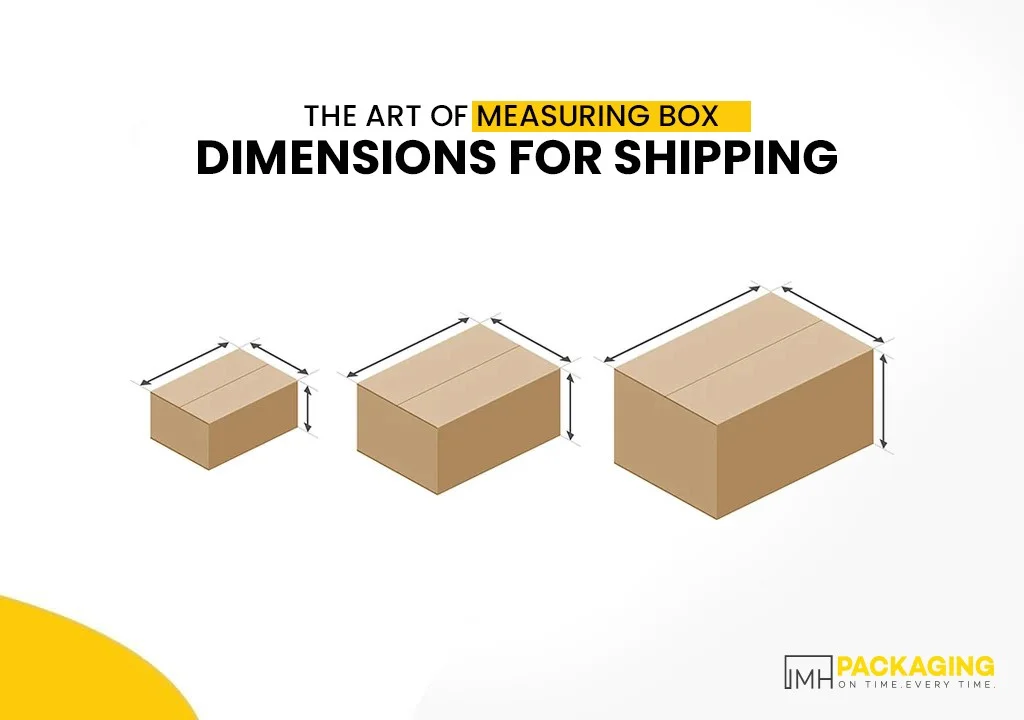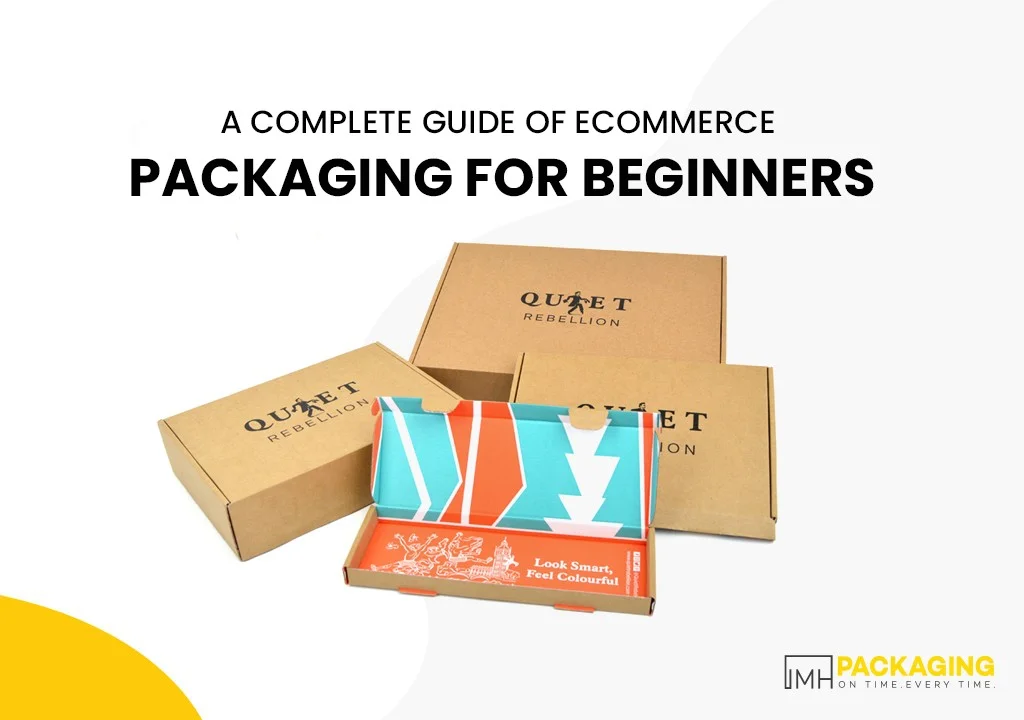In today`s digital era, the adaptability of
shipping boxes permits us to transport nearly anything securely and
advantageously. Whether you want to send fragile merchandise, a massive
bedding, or a sensitive antique crystal chandelier, there is a box that accommodates
your particular prerequisites. In any case, it is significant to comprehend how
to measure a box precisely to pick the right dimensions and style. Shipping
parcels is a common practice in today`s globalized world. Whether you`re
sending a care package to a friend, distributing products to customers, or
relocating to a new home, understanding the art of measuring box dimensions for
shipping is essential. In addition, properly measured and labelled boxes are
more cost-effective to ship and help prevent damage during transit.
In this comprehensive guide of calculating a
box`s dimensions, we`ll delve into the intricacies of box measurement,
explaining the techniques and considerations for different scenarios. IMH
Packaging is one of the top packaging suppliers of shipping boxes shares an
itemized guide on how to measure box dimensions, allowing you to settle on
informed choices for your delivery and packaging needs. The dimensions of a box
are something beyond numbers; they`re the groundwork of an item`s safety,
cost-effectiveness, and overall display. While calculating a box dimension
could appear as a straightforward errand, guaranteeing exactness is
fundamental, particularly regarding custom packaging. We should explore the
subtleties of measuring box dimensions and why they are significant for your
business.
Measure the Box Size Correctly
Recollect the well-known saying, "Measure
two times and cut once"? A similar rule executes to box dimensions. Before
ordering custom boxes or making bulk buys, you must guarantee you select the
right size. Just assessing or eye-balling box dimensions for shipping wouldn`t
do the trick. Set aside some margin to measure precisely, keeping away from
expensive errors.
Have Knowledge About Box Dimensions
There are two significant measurements regarding
box dimensions: the inside and outside measurements. For instance, a typical
16″x12″x12″ box addresses its inside measurements. Be that as it may, a similar
box will have marginally bigger external measurements, identical to 16 3/8″ x
12 3/8″ x 12 5/8″. Understanding the distinction between inside and outside box
dimensions is indispensable to avoid fit issues. Before you even contemplate
box manufacturing, getting a handle on the three essential elements of any box
is fundamental: length, width, and volume. Here is a fast breakdown:
Length
The length of a custom box is ordinarily its
longest side when seen from the top of the opening. It fills in as the
essential aspect that frequently decides the direction of the packaging box.
Generally speaking, the length relates to the horizontal dimension of the item
inside, particularly for prolonged things. While measuring the length, it`s
vital to start from one end and broaden the measuring tape straight across to
the far edge, guaranteeing it`s tight and level. The length is vital in
deciding the direction of the box and frequently relates to the essential
dimension of the item inside.
Width
The width of a shipping box is the more limited
side while checking the top out. It`s opposite to the length and frequently
decides the front face of the box, particularly in product display packaging.
While measuring the width, guarantee that the measuring tape ranges from one
side to the next with practically no leeway. It`s additionally important that
the width can differ because of the design of the shipping box, particularly
assuming it has novel shapes or cutouts. The width is crucial for display
purposes and can impact how an item is exhibited on retail shelves.
Height or Depth
Depth, reciprocally alluded to as height, is the
side opposite of the length and width. It decides how tall the shipping box
stands. The depth is a basic measurement for stacked items or needing to fit
inside unambiguous storage limitations. On account of a shoebox, for instance,
the depth would oblige the height of the shoe boxes stacked on top of one
another. Measuring the depth requires an upward box measurement from the
foundation of the box to its highest point. For packages with covers or folds,
measure the depth, including the folds, as they diminish the usable inside box
dimensions. Depth is critical for understanding how items will be stacked or
stored, guaranteeing productive utilization of space.
Volume
Whenever you have three box dimensions, now is
the right time to work out the volume. This isn`t just about how much space is
inside the box; it`s tied in with streamlining material use, diminishing
expenses, and guaranteeing the primary uprightness of your custom packaging. To
work out the volume, utilize the basic equation: Volume = length x width x
depth. At the same time, it`s conceivable to calculate volume without knowing
which measurement is which; keeping them directly is a decent practice to avoid
disarray.
Why Volume Matters for Product Storage
The volume of a shipping box decides how cozily
an item will fit inside. A box with the right volume guarantees the item is
safe and shown ideally and stylishly when unpacked. Realizing the volume
assists in choosing the right amount of defensive packaging material, lessening
waste and expenses. Misjudging volume can prompt pointless material expenses
while underrating can make one think twice about an item`s security.
Transporters frequently charge because of the bundles` volume (or layered
weight). A box with enhanced volume can prompt significant savings in delivery
costs. Also, understanding volume helps with proficient warehousing, taking
into consideration better stacking and storage. IMH Packaging can help you
figure out professional warehousing and how to calculate box dimensions for
shipping.
The Significance of Internal Box Dimensions
Continuously measure the inside of the box, not
the outside. Why? Since the business standard depends on inward box dimensions.
This distinction is critical for guaranteeing that your item fits cozily and
safely inside its custom packaging. Measuring box sizes for shipping could
appear to be more straightforward. However, it doesn`t represent the thickness
of the box material. This can be particularly deceptive with corrugated boxes,
where the fluting adds millimetres to each outer box measurement.
Measuring box dimensions probably won`t be
advanced science. However, it requires attention to detail. Whether you`re
working out a volume or settling on inside and outside measurements, exactness
is significant. With these bits of knowledge, you`re exceptional at handling
any packaging project. Moreover, if you need expert guidance, recall that
expert assistance is only a click away. IMH Packaging couldn`t want anything
more than to assist with bringing your packaging ideas to life.
Box Size Terminology
Inventories and sites, for the most part, allude
to box sizes utilizing inside dimensions. Measurements are recorded in length,
width, and height (L x W x H). While measuring for a custom box, measure
accuracy by measuring the specific cubic size to the nearest 1/tenth of an
inch. Utilize a ruler or measuring tape to double-check your box measurements.
Have Knowledge About Shipping Costs
Deciding the outside measurements of your shipping
box is basic for working out transportation costs. While transportation costs
could shift across administrations and transporters, you can assess costs based
on their particular box size rules. FedEx and USPS offer thorough rules for
delivery box sizes, assisting you with expecting prices. Remember that shipping
boxes falling outside the standard pricing rules might bring higher
transportation costs. You must know how to measure a package to get the right
price for shipping your packaging boxes.
Authenticating Box Volume and Pallet Efficiency
In the wake of sealing and packing your box,
measure its inside dimensions against the outside dimensions. This will give
you an understanding of the box`s volume, assisting you with deciding the space
it will involve during transportation. For bulk shipments, the outside
measurements will help you assess the number of boxes that can fit on a pallet
productively. The exact measurement of box dimensions is fundamental for
fruitful delivery and packaging endeavors.
Measuring Box Dimensions
For standard rectangular or square boxes,
measuring the length, width, and height is straightforward:
Length: Measure the longest side
of the box from one corner to the opposite corner. Ensure the measuring tape is
straight and aligned with the edges.
Width: Measure the shorter side
of the box, again from one corner to the opposite corner.
Height: Measure the distance
from the bottom of the box to the top. Ensure the measuring tape is
perpendicular to the length and width measurements.
Measure Irregularly Shaped Boxes
If your box is not a perfect rectangle or square,
you may need to measure additional dimensions:
Diameter: For cylindrical or
round objects, measure the diameter (the distance across the widest part). If
the thing is long, also measure the length.
Girth: In some cases, you`ll
need to measure the girth, which is the total distance around the box. To
measure girth, wrap the measuring tape around the widest part of the box.
Record the Measurements
After measuring, record the dimensions as
follows: Length x width x height (in that order). For example, if your box
measures 12 inches in length, 8 inches in width, and 6 inches in height, the
recorded dimensions would be 12" x 8" x 6".
Measure the Weight
Use a scale to weigh the box with its contents.
If you`re shipping multiple packages, weigh each one individually. Record the
weight accurately, including any packaging materials that add to the total
weight.
Packaging Considerations You Need to Keep in Mind
In addition to measuring box dimensions, consider
the following packaging aspects:
Packaging Materials: Ensure the
box is adequately padded to protect the contents during transit. Bubble wrap,
packing peanuts, or crumpled paper can help safeguard fragile items.
Box Strength: Choose a box that
can support the weight of its contents. Corrugated cardboard boxes are a
popular choice for their durability.
Sealing: Use quality packaging
tape to seal the box securely. Ensure all seams are sealed to prevent items
from falling out.
Labelling: Label the box with
the recipient`s address and contact information. It`s also a good practice to
include a return address.
Fragile Items: Mark boxes
containing fragile items to alert handlers to exercise caution.
Have Complete Knowledge of Shipping Carrier Guidelines
Different shipping carriers may have varying
guidelines for box dimensions and weight limits. In addition, always check the
specific requirements of your chosen carrier, as failure to comply can result
in delays, additional fees, or even returned shipments. Some common guidelines
include:
Maximum Weight: Most carriers
have weight limits for each package, ranging from 50 to 70 pounds (22.7 to 31.8
kilograms).
Maximum Dimensions: Carriers may
specify maximum dimensions for a package. These can vary, but a common
guideline is a full length and girth (combined) of 108 inches.
Oversized Packages: If your
package exceeds the carrier`s maximum dimensions, it may be considered large,
incurring additional fees.
Dimensional Weight: Some
carriers calculate shipping costs based on dimensional weight rather than the
actual weight. This means that larger, lighter packages can be more expensive
to ship.
Tips for Efficient Shipping
To streamline your shipping process and ensure
efficiency, consider the following tips:
Standardized Box Sizes: Use
standard box sizes to optimize packing and save on shipping costs.
Remove Unnecessary Space: Use
packing materials to fill empty spaces within the box. This minimizes movement
during transit and prevents damage.
Weight Distribution: Distribute
heavy items evenly within the box to prevent it from becoming top-heavy or
unbalanced.
Labeling and Documentation:
Label your boxes, including complete addresses and contact information.
Moreover, keep records of shipments, tracking numbers, and receipts.
International Shipping: If
shipping internationally, be aware of customs regulations and required
documentation, such as customs forms and invoices.
Final Thoughts
By following the means framed in this complete
guide from a famous name in the packaging industry called IMH Packaging, you
can certainly calculate the dimensions of a box, select fitting sizes, and
estimate delivery costs. Remember to consider interior and exterior dimensions,
verify measurements using precise tools, and use available resources from
shipping services to guide your decision-making process. However, with proper
measurements, you can ensure secure packaging, cost-effective shipping, and
efficient use of space during transportation.
Measuring box dimensions for shipping is a
fundamental aspect of sending parcels, whether for personal or business
purposes. It ensures cost efficiency, damage prevention, and compliance with
shipping carrier guidelines. In addition, following the proper techniques and
considering packaging and carrier guidelines can make the shipping process
smoother and more cost-effective. Whether sending a heartfelt gift or managing
a business`s logistics, accurate box measurement is the key to a successful
shipping experience.






